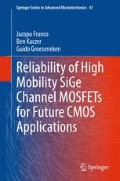Abstract
The first part of this Chapter is devoted to a general study of CHC degradation in pMOSFETs, which is relevant for novel Ge-based devices but suffers of a lack of literature due to the reduced relevance in standard Si technologies. First, an experimental methodology to study the interplay of HC and NBTI is discussed. The study is performed firstly on standard Si/SiON/poly-Si devices and then validated on a more recent high-k/metal gate technology. The learning is consequently used for interpreting the experimental observation on the novel SiGe pMOSFETs. Next, the HC degradation in pure Ge channel devices is investigated, with particular focus on the junction engineering which is expected to have an impact on the device reliability. The second part of this Chapter briefly discusses the impact of other reliability mechanisms, namely 1/f noise and Time Dependent Dielectric Breakdown (TDDB), on (Si)Ge channel devices as compared to standard Si reference.
Access this chapter
Tax calculation will be finalised at checkout
Purchases are for personal use only
References
D. Vuillaume, Hot carrier injections in SiO2 and related instabilities in submicrometer mosfets, in Instabilities in Silicon Devices, ed. by G. Barbottin, A. Vapaille, vol. 3 (Elsevier, Amsterdam, 1999), pp. 265–339
V. Huard, M. Denais, C. Parthasarathy, NBTI degradation: from physical mechanism to modeling. Microlectron. Reliab. 46(1), 1–23 (2006)
T. Grasser et al., The paradigm shift in understanding the bias temperature instability: from reaction-diffusion to switching oxide traps. IEEE Trans. Electron Dev. 58(11), 3652–3666 (2011)
W.-Y Loh et al., The effects of Ge composition and Si cap thickness on hot carrier reliability of Si/Si1-xGex/Si p-MOSFETs with high-K/metal gate, in Proceedings of the symposium on VLSI Technology, pp. 56–57 (2008)
D. Maji et al., Understanding and optimization of hot-carrier reliability in Germanium-on-Silicon pMOSFETs. IEEE Trans. Electron Dev. 56(5), 1063–1069 (2009)
E. Amat et al., Channel Hot-Carrier degradation under static stress in short channel transistors with high-k/metal gate stacks, in IEEE Proc. ULIS, pp. 103–106 (2008)
B. Kaczer et al., Ubiquitous relaxation in BTI stressing—new evaluation and insights, in IEEE Proceedings of the IRPS, pp. 20–27 (2008)
T. Grasser et al., Simultaneous extraction of recoverable and permanent components contributing to Bias-Temperature Instability. in IEEE Proceedings of the IEDM, pp. 801–804 (2007)
A. Lacaita, Why the effective temperature of the hot electron tail approaches the lattice temperature. App. Phys. Lett. 59(13), 1623–1625 (1991)
S.E. Tyaginov et al., Hot-carrier degradation modeling using full-band Monte-Carlo simulations, in IEEE Proceedings of the international symposium on the physical and failure analysis of integrated circuits (IPFA), pp. 1–5 (2010)
A. Teramoto, R. Kuroda, T. Ohmi, NBTI mechanism based on hole-injection for accurate lifetime prediction. ECS Trans. 6(3), 229–243 (2007)
M.G. Ancona, N.S. Saks, D. McCarthy, Lateral distribution of hot-carrier-induced interface traps in MOSFETs. IEEE Trans. Electron Dev. 35(12), 2221–2228 (1988)
C. Guerin et al., Combined effect of NBTI and channel hot carrier effects in pMOSFETs, in IEEE Proceedings of the IIRW, pp. 10–16 (2005)
C.-H. Jeon, S.-Y. Kim, C.-B. Rim, The impact of NBTI and HCI on deep sub-micron pMOSFETs’ lifetime, in IEEE Proceedings of the IIRW, pp. 130–132 (2002)
R. Mishra et al., On the interaction of ESD, NBTI and HCI in 65 nm Technology, in IEEE Proceedings of the IRPS, pp. 17–22 (2007)
B. De Jaeger, G. Nicholas, D.P. Brunco, G. Eneman, M. Meuris, M. Heyns, High performance high-k/Metal Gate Ge pMOSFETs with Gate Lengths down to 125 nm and Halo implant. in Proceedings of the ESSDERC, 2007
G. Enema et al., Impact of donor concentration, electric field, and temperature effects on the leakage current in Germanium p+/n Junctions. IEEE Trans. Electron Devices, 55(9) (2008)
G. Eneman et al., Quantification of drain extension leakage in a scaled bulk Germanium PMOS Technology. IEEE Trans. Electron Dev. 56(12) (2009)
C. Hu, S.C. Tam, F.-C. Hsu, P.-K. Ko, T.-Y. Chan, K.W. Terrill, Hot-electron-induced MOSFET degradation—model, monitor, and improvement. IEEE J. Solid-State Circ. sc-20(1) (1985)
Sentaurus Process Reference Manual, 2006. X-2006.06 ed
Taurus Medici User Guide, 2007. A-2007.12 ed
B. Kaczer et al., NBTI from the perspective of defect states with widely distributed time scales, in IEEE Proceedings of the IRPS, pp. 55–60 (2009)
A.K. Raychaudhuri, Measurement of 1/f noise and its application in materials science. Solid State Mater. Sci. 6 (2002)
B. Kaczer et al., Electrical and reliability characterization of metal-gate/HfO2/Ge FET’s with Si passivation. Microelectron. Eng. 84(9–10), 2067–2070 (2007)
S. Sahhaf et al., A new TDDB reliability prediction methodology accounting for multiple SBD and wear out. IEEE Trans. Electron Dev. 56(7), 1424–1432 (2009)
T. Kauerauf et al., “Methodologies for sub-1 nm EOT evaluation”, in IEEE Proc. IRPS, pp. 2A.2.1-10, 2011
Author information
Authors and Affiliations
Corresponding author
Rights and permissions
Copyright information
© 2014 Springer Science+Business Media Dordrecht
About this chapter
Cite this chapter
Franco, J., Kaczer, B., Groeseneken, G. (2014). Channel Hot Carriers and Other Reliability Mechanisms. In: Reliability of High Mobility SiGe Channel MOSFETs for Future CMOS Applications. Springer Series in Advanced Microelectronics, vol 47. Springer, Dordrecht. https://doi.org/10.1007/978-94-007-7663-0_6
Download citation
DOI: https://doi.org/10.1007/978-94-007-7663-0_6
Published:
Publisher Name: Springer, Dordrecht
Print ISBN: 978-94-007-7662-3
Online ISBN: 978-94-007-7663-0
eBook Packages: EngineeringEngineering (R0)

